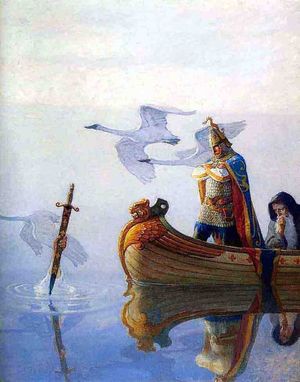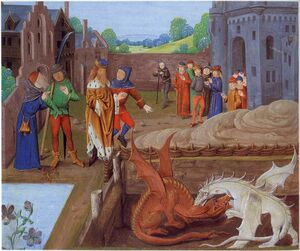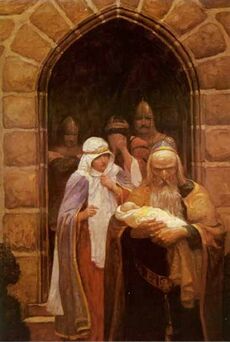Merlin

In the fifth century, Saint Germain was embodied as Merlin—alchemist, prophet and counsellor at the court of King Arthur.
Merlin first appears in the history of England prior to the birth of Arthur as mediator among barons and war lords during the sixth century. Like those of Arthur, Launcelot and Guinevere, his story is recorded in the folk tales of nearly every European nation.
In some traditions, Merlin is described as a godly sage who studied the stars and whose prophecies were recorded by seventy secretaries. The Prophecies of Merlin, which deals with events extending from Arthur’s time into the distant future, was popular in the Middle Ages.
Merlin’s birth
In the 12th century, Geoffrey of Monmouth, in his major work History of the Kings of Britain, depicts Merlin as a kind of wonder-child who can see into the future. According to the traditional legend, he is half man and half demon. (It is said his father was a demon and his mother, a princess.) But we must examine this a little further to understand what is truly meant.
Robert de Boron takes his story a little bit further. He, the 13th-century poet who wrote Merlin, says the Devil had plotted to produce an antichrist, with a demon for a father and a virgin for a mother. He says that the plan was thwarted when Merlin’s virtuous mother tells her confessor she has conceived by a demon. He gives her holy water to drink and makes her take a vow of lifelong chastity.
Thus Merlin is born without his father’s evil ways but retains superhuman powers, including the ability to see into the past and the future. The child Merlin is depicted as a prodigy. He could speak at birth. He dictates the history of the Holy Grail while still a baby.
Now we realize the one writing in the 13th century about Merlin is writing almost to justify history through the eyes of the Christian Church. He cannot imagine a man of such powers except he be a demon. Even Jesus was accused of casting out devils by Beelzebub, and he said it cannot be that the power of God could manifest by the power of Satan.
What in truth is happening here is that the mother who typifies the Christian saint is wed to the ancient tradition of priesthood. She marries a Druid priest, who has all of the powers of the ancient mysteries, the tradition of the Holy Grail, two thousand years and more of the path of self-mastery.
We perceive also that the very mystery of the Holy Grail itself antedates Christianity and is a conception that merely comes into what is always inevitably there: the vessel, the bowl, the sacred chalice—that Grail and that chalice being the perfected matrix of the soul to receive the divine light. Those bowls were on the altar of the temples long before the Christian era.
So Merlin is one who does not quite fit in to the Christian way of thinking, and therefore, somehow to justify this extraordinary power, which is easily equal to or greater than that displayed by Jesus, we have a Christian’s eye view of this conception.
Corinne Heline writes of Merlin’s birth:
Merlin knew the ancient teachings handed down from the farthest past—from Lemuria and Atlantis, from Babylon and Egypt, from Greece and Rome—and summed it up in the sublime wisdom of Glastonbury.
Born of a “human” Christian mother and an “archdemon” (a Druid High Priest) father, his name was said to signify “serpent babe” or “wondrous one”—for he possessed the wisdom of the serpent without its guile. He was a strange being in whom Celtic magic and Christian mysticism were blended.
We understand that the meaning of the term serpent has to do with sacred fire and the raising of the Kundalini from the base to the crown chakra. Thus we begin to understand out of what ancient tradition emerges Merlin, who himself was embodied as a priest of the sacred fire under the order of Lord Zadkiel when on Atlantis.

Childhood
Geoffrey of Monmouth tells this story of the wonder-child Merlin and Vortigern, King of Britain, who is being attacked by the Saxons:
Vortigern and his court fled to Wales, where his magicians advised him to build a strong tower as a safe retreat. He chose a site for the tower in the mountains of Snowdonia, but his workmen’s efforts to build it were frustrated because the foundations kept sinking into the ground. Vortigern’s magicians told him that the only remedy was to find a boy who had no father, sacrifice him, and sprinkle the foundations with his blood.
Men were sent to scour the country for a boy with no father, and one was found at Carmarthen. His name was Merlin and he was the grandson of the King of Dyfed. No mortal man had sired him.
This concept of not being sired by a mortal is actually the true mystery of the conception of Jesus Christ by the Holy Spirit—carried in the Holy Grail of a living individual who had the initiation and the God-Mastery of that office of the Holy Spirit—namely beloved Joseph.
So here we find again the myth that in order to have holiness one must not be sired by a mortal—when the truth of the mystery is that one must be sired by one in embodiment who is the vessel, the Holy Grail of the seed of the Holy Ghost; and the mother being the Holy Grail and the vessel of the divine womb, the Divine Mother.
They found the child and they brought the youthful Merlin before Vortigern. Standing before the royal magicians, Merlin had nothing but blistering contempt for them. He tells the king that his tower would not stand because there was a pool in the ground beneath it—a fact which his magicians had been too incompetent to discern.
At the bottom of the pool, Merlin said, were two hollow stones, and inside the stones were dragons. Vortigern’s workmen dug down and found the pool. From it emerged two fire-breathing dragons, one red and one white, which began to fight.”
He explained to the astonished Vortigern that the portent of these two dragons fighting meant that the British (the red dragon) would be hard-pressed by the Saxons (the white dragon) until the coming of the Boar of Cornwall (the Boar of Cornwall would be none other than King Arthur), who would trample the Saxons beneath his feet. Merlin went on to deliver a long string of prophecies in obscure symbolic language, and Vortigern was vastly impressed.

Merlin and Arthur
According to Thomas Malory’s account Le Morte d’Arthur, Merlin stands highly revered as the king’s counselor, at times appearing disguised—once “all befurred in black sheepskins and a great pair of boots”—in order to convey the imminent message, warning, or initiation.
According to Malory, Arthur was born to Uther Pendragon, “king of all England,” and noble Queen Igraine at Merlin’s own bidding with the understanding that the child would be delivered to Merlin as soon as he was born. And so the tiny newborn babe bound in a cloth of gold was brought to the “poor man” at the postern gate of the castle and taken to Sir Ector whose wife nourished him at her own breast. Merlin called a holy man to christen him and named the child Arthur.
Within two years, while King Uther lay mortally ill, his enemies “did a great battle upon his men and slew many of his people.” Merlin bade the king to ride into the battlefield on a stretcher, for “if your person be there ... then shall ye have the victory.” So it was at St. Albans that Uther’s men overcame the “great host of the North.”
The dying king returned to London where Merlin called together all the barons of Uther’s realm in order that the king might name his heir. And Merlin said aloud, “‘Shall your son Arthur be king after your days?’” And Uther answered, “‘I give him God’s blessing and mine’ ... wherewith he yielded up the ghost.”
The land of England stood then “in jeopardy a long while,” for many rose up attempting to capture the crown by force. So Merlin went before the Archbishop of Canterbury and counseled him to call all the lords of the realm to London at Christmas in order that Jesus, born King of Kings, might come to show who should rule England.
By the alchemy of the Christ consciousness, Merlin caused the sword and the stone to appear in the churchyard of Canterbury cathedral with these words: “Whosoever pulleth out this sword of this stone and anvil, is rightwise king born of all England.” By the trial of the sword—representing the power of the soul that is free from the bondage of attachment to things material symbolized by the stone and anvil—Arthur proved his kingship.
Thus, we see Merlin in the role of the one who anointed the king of the Britons. And this was also his role in his incarnation as the prophet Samuel—the anointer of kings. So too, our Saint Germain, as the sponsor of America today, did anoint our first president, George Washington.
Thereafter, Merlin remained at Arthur’s side as counselor and friend. The young king once would have died by the sword of mighty Pellinore had not Merlin appeared and “cast an enchantment” upon the knight. It was because Arthur’s sword was smitten in two during that fierce joust that Merlin and Arthur rode to the lake where they miraculously beheld rising from the water the arm of the Lady of the Lake holding the magnificent sword Excalibur. Merlin later counseled him, “Look ye keep well the scabbard of Excalibur for ye shall lose no blood while ye have the scabbard upon you”—a prediction well fulfilled in future years.
It was Merlin who went before King Leodegrance to announce the desire of Arthur to wed his daughter Guinevere. He returned triumphantly to Camelot with Lady Guinevere and the Round Table, a gift to Leodegrance from Arthur’s father, Uther Pendragon.
Merlin revealed the mystery of the blessed Sangreal (Holy Grail) to king and queen, knights and ladies at Camelot and, early in Arthur’s reign, prophesied the day of the “great battle beside Salisbury and Modred his own son would be against him.”

Merlin’s passing
There are a number of accounts of Merlin’s demise. One story says that he disappeared into the House of Glass on Bardsey Island off the coast of Wales—having taken the Thirteen Treasures of Britain with him. It is said that he is there to this day, unseen by human eyes.
One 13th-century legend says Merlin survived Arthur and his knights. When Arthur was defeated in battle by Mordred, he retreated into a bird cage.
The most popular version of the story of Merlin’s demise is that a beautiful maiden named Vivien, Niviene, Nimue, or a variation thereof—who is in some legends identified as the Lady of the Lake—uses the magic she learned from Merlin himself to imprison him for life.
Finally, another story of Merlin’s mysterious disappearance from Arthur’s court is told in The High History of the Holy Grail, an Arthurian romance written by an unknown author in old French prose somewhere around 1200: One day, Arthur, Launcelot, and Gawain come across the ruined castle of Tintagel with a chapel next to it. The priest tells the three about the sepulchre inside the chapel:
“Lords, in this sepulchre was placed the body of Merlin, but never mought it be set inside the chapel, wherefore perforce it remained outside.
“And know of a very truth that the body lieth not within the sepulchre; for, so soon as it was set therein, it was taken out and snatched away—either on God’s behalf or the Enemy’s, but which we know not.”
So one can consider this to be the resurrection or the drawing up into this Cloud of the Law of the disciple, taken up by God almost as a babe in arms at that final moment prior to being reborn in the Spirit.
See also
Sources
Elizabeth Clare Prophet, December 31, 1976.
Elizabeth Clare Prophet, April 21, 1984.
Elizabeth Clare Prophet, Saint Germain On Prophecy
